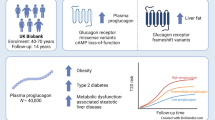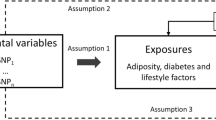Abstract
Aims
Individuals with type 2 diabetes have an increased risk of developing non-alcoholic fatty liver disease (NAFLD), and NAFLD patients are also at greater risk for developing type 2 diabetes. Although the relationship between type 2 diabetes and NAFLD is highly interconnected, the pathogenic mechanisms linking the two diseases are poorly understood. The goal of this study was to identify genetic determinants of hepatic lipid accumulation through association analysis using histological phenotypes in obese individuals.
Methods
Using the Illumina HumanOmniExpress BeadChip assay, we genotyped 2,300 individuals on whom liver biopsy data were available.
Results
We analyzed total bilirubin levels, which are linked to fatty liver in severe obesity, and observed the strongest evidence for association with rs4148325 in UGT1A (P < 5.0 × 10−93), replicating previous findings. We assessed hepatic fat level and found strong evidence for association with rs4823173, rs2896019, and rs2281135, all located in PNPLA3 and rs10401969 in SUGP1. Analysis of liver transcript levels of 20 genes residing at the SUGP1/NCAN locus identified a 1.6-fold change in the expression of the LPAR2 gene in fatty liver. We also observed suggestive evidence for association between low-grade fat accumulation and rs10859525 and rs1294908, located upstream from SOCS2 and RAMP3, respectively. SOCS2 was differentially expressed between fatty and normal liver.
Conclusions
These results replicate findings for several hepatic phenotypes in the setting of extreme obesity and implicate new loci that may play a role in the pathophysiology of hepatic lipid accumulation.


Similar content being viewed by others
Abbreviations
- NAFLD:
-
Non-alcoholic fatty liver disease
- PNPLA3 :
-
Patatin-like phospholipase domain containing 3 gene
- UGT1A :
-
Uridine 5′-diphospho-glucuronosyltransferase
- SUGP1 :
-
SURP and G patch domain containing 1 gene
- NCAN :
-
Neurocan
- LPAR2 :
-
Lysophosphatidic acid receptor 2
- RAMP3 :
-
Receptor (G protein-coupled) activity modifying protein 3
- SOCS2 :
-
Suppressor of cytokine signaling 2
References
Wang Y, Li YY, Nie YQ, Zhou YJ, Cao CY, Xu L (2013) Association between metabolic syndrome and the development of non-alcoholic fatty liver disease. Exp Ther Med 6:77–84
Fabbrini E, Sullivan S, Klein S (2010) Obesity and nonalcoholic fatty liver disease: biochemical, metabolic, and clinical implications. Hepatology 51:679–689
Birkenfeld AL, Shulman GI (2014) Nonalcoholic fatty liver disease, hepatic insulin resistance, and type 2 diabetes. Hepatology 59:713–723
Day CP (2006) Genes or environment to determine alcoholic liver disease and non-alcoholic fatty liver disease. Liver Int Off J Int Assoc Study Liver 26:1021–1028
Machado M, Marques-Vidal P, Cortez-Pinto H (2006) Hepatic histology in obese patients undergoing bariatric surgery. J Hepatol 45:600–606
Browning JD, Kumar KS, Saboorian MH, Thiele DL (2004) Ethnic differences in the prevalence of cryptogenic cirrhosis. Am J Gastroenterol 99:292–298
Caldwell SH, Harris DM, Patrie JT, Hespenheide EE (2002) Is NASH underdiagnosed among African Americans? Am J Gastroenterol 97:1496–1500
Struben VM, Hespenheide EE, Caldwell SH (2000) Nonalcoholic steatohepatitis and cryptogenic cirrhosis within kindreds. Am J Med 108:9–13
Willner IR, Waters B, Patil SR, Reuben A, Morelli J, Riely CA (2001) Ninety patients with nonalcoholic steatohepatitis: insulin resistance, familial tendency, and severity of disease. Am J Gastroenterol 96:2957–2961
Schwimmer JB, Celedon MA, Lavine JE et al (2009) Heritability of nonalcoholic fatty liver disease. Gastroenterology 136:1585–1592
Wilfred de Alwis NM, Day CP (2008) Genes and nonalcoholic fatty liver disease. Curr DiabRep 8:156–163
Romeo S, Kozlitina J, Xing C et al (2008) Genetic variation in PNPLA3 confers susceptibility to nonalcoholic fatty liver disease. Nat Genet 40:1461–1465
Hotta K, Yoneda M, Hyogo H et al (2010) Association of the rs738409 polymorphism in PNPLA3 with liver damage and the development of nonalcoholic fatty liver disease. BMC Med Genet 11:172
Kantartzis K, Peter A, Machicao F et al (2009) Dissociation between fatty liver and insulin resistance in humans carrying a variant of the patatin-like phospholipase 3 gene. Diabetes 58:2616–2623
Petit JM, Guiu B, Masson D et al (2011) PNPLA3 polymorphism influences liver fibrosis in unselected patients with type 2 diabetes. Liver Int Off J Int Assoc Study Liver 31:1332–1336
Romeo S, Sentinelli F, Dash S et al (2010) Morbid obesity exposes the association between PNPLA3 I148 M (rs738409) and indices of hepatic injury in individuals of European descent. Int J Obes (Lond) 34:190–194
Rotman Y, Koh C, Zmuda JM, Kleiner DE, Liang TJ (2010) The association of genetic variability in patatin-like phospholipase domain-containing protein 3 (PNPLA3) with histological severity of nonalcoholic fatty liver disease. Hepatology 52:894–903
Sookoian S, Castano GO, Burgueno AL, Gianotti TF, Rosselli MS, Pirola CJ (2009) A nonsynonymous gene variant in the adiponutrin gene is associated with nonalcoholic fatty liver disease severity. J Lipid Res 50:2111–2116
Wang CW, Lin HY, Shin SJ et al (2011) The PNPLA3 I148 M polymorphism is associated with insulin resistance and nonalcoholic fatty liver disease in a normoglycaemic population. Liver Int Off J Int Assoc Study Liver 31:1326–1331
Liew PL, Lee WJ, Wang W et al (2008) Fatty liver disease: predictors of nonalcoholic steatohepatitis and gallbladder disease in morbid obesity. Obes Surg 18:847–853
Chisholm J, Seki Y, Toouli J, Stahl J, Collins J, Kow L (2012) Serologic predictors of nonalcoholic steatohepatitis in a population undergoing bariatric surgery. Surg Obes Relat Dis Off J Am Soc Bariatr Surg 8:416–422
Dong H, Huang H, Yun X et al (2014) Bilirubin increases insulin sensitivity in leptin-receptor deficient and diet-induced obese mice through suppression of er stress and chronic inflammation. Endocrinology 155:818–828
Cox AJ, Ng MC, Xu J et al (2013) Association of SNPs in the UGT1A gene cluster with total bilirubin and mortality in the Diabetes Heart Study. Atherosclerosis 229:155–160
Kleiner DE, Brunt EM, Van Natta M et al (2005) Design and validation of a histological scoring system for nonalcoholic fatty liver disease. Hepatology 41:1313–1321
Wood GC, Chu X, Manney C et al (2012) An electronic health record-enabled obesity database. BMC Med Inform Decis Mak 12:45
Johnson AD, Handsaker RE, Pulit SL, Nizzari MM, O’Donnell CJ, de Bakker PI (2008) SNAP: a web-based tool for identification and annotation of proxy SNPs using HapMap. Bioinformatics 24:2938–2939
Still CD, Craig Wood G, Chu X, et al (2013) Clinical factors associated with weight loss outcomes after Roux-en-Y gastric bypass surgery. Obesity (Silver Spring) 22(3):888–894
Speliotes EK, Yerges-Armstrong LM, Wu J et al (2011) Genome-wide association analysis identifies variants associated with nonalcoholic fatty liver disease that have distinct effects on metabolic traits. PLoS Genet 7:e1001324
Dai X, Wu C, He Y et al (2013) A genome-wide association study for serum bilirubin levels and gene-environment interaction in a Chinese population. Genet Epidemiol 37:293–300
Chen G, Ramos E, Adeyemo A et al (2012) UGT1A1 is a major locus influencing bilirubin levels in African Americans. Eur J Human Genet 20:463–468
Johnson AD, Kavousi M, Smith AV et al (2009) Genome-wide association meta-analysis for total serum bilirubin levels. Hum Mol Genet 18:2700–2710
Kitamoto T, Kitamoto A, Yoneda M et al (2013) Genome-wide scan revealed that polymorphisms in the PNPLA3, SAMM50, and PARVB genes are associated with development and progression of nonalcoholic fatty liver disease in Japan. Hum Genet 132:783–792
Chalasani N, Guo X, Loomba R, et al. (2010) Genome-wide association study identifies variants associated with histologic features of nonalcoholic Fatty liver disease. Gastroenterology 139:1567–1576, 1576 e1561–1566
Speliotes EK, Butler JL, Palmer CD et al (2010) PNPLA3 variants specifically confer increased risk for histologic nonalcoholic fatty liver disease but not metabolic disease. Hepatology 52:904–912
Gorden A, Yang R, Yerges-Armstrong LM et al (2013) Genetic variation at NCAN locus is associated with inflammation and fibrosis in non-alcoholic fatty liver disease in morbid obesity. Hum Hered 75:34–43
Verrijken A, Beckers S, Francque S et al (2013) A gene variant of PNPLA3, but not of APOC3, is associated with histological parameters of NAFLD in an obese population. Obesity 21:2138–2145
Gordon L, Joo JE, Powell JE et al (2012) Neonatal DNA methylation profile in human twins is specified by a complex interplay between intrauterine environmental and genetic factors, subject to tissue-specific influence. Genome Res 22:1395–1406
Kozlitina J, Smagris E, Stender S et al (2014) Exome-wide association study identifies a TM6SF2 variant that confers susceptibility to nonalcoholic fatty liver disease. Nat Genet 46:352–356
Rancoule C, Attane C, Gres S et al (2013) Lysophosphatidic acid impairs glucose homeostasis and inhibits insulin secretion in high-fat diet obese mice. Diabetologia 56:1394–1402
Sankella S, Garg A, Horton JD, Agarwal AK (2014) Hepatic gluconeogenesis is enhanced by phosphatidic acid which remains uninhibited by insulin in lipodystrophic Agpat2-/- mice. J Biol Chem 289:4762–4777
Kumashiro N, Yoshimura T, Cantley JL et al (2013) Role of patatin-like phospholipase domain-containing 3 on lipid-induced hepatic steatosis and insulin resistance in rats. Hepatology 57:1763–1772
Kashyap SR, Diab DL, Baker AR et al (2009) Triglyceride levels and not adipokine concentrations are closely related to severity of nonalcoholic fatty liver disease in an obesity surgery cohort. Obesity (Silver Spring) 17:1696–1701
Rasche A, Al-Hasani H, Herwig R (2008) Meta-analysis approach identifies candidate genes and associated molecular networks for type-2 diabetes mellitus. BMC Genom 9:310
Zadjali F, Santana-Farre R, Vesterlund M et al (2012) SOCS2 deletion protects against hepatic steatosis but worsens insulin resistance in high-fat-diet-fed mice. FASEB journal : official publication of the Federation of American Societies for Experimental Biology 26:3282–3291
Tateno C, Kataoka M, Utoh R et al (2011) Growth hormone-dependent pathogenesis of human hepatic steatosis in a novel mouse model bearing a human hepatocyte-repopulated liver. Endocrinology 152:1479–1491
Lebrun P, Cognard E, Gontard P et al (2010) The suppressor of cytokine signalling 2 (SOCS2) is a key repressor of insulin secretion. Diabetologia 53:1935–1946
Elam MB, Cowan GS Jr, Rooney RJ et al (2009) Hepatic gene expression in morbidly obese women: implications for disease susceptibility. Obesity 17:1563–1573
Westermark GT, Westermark P (2013) Islet amyloid polypeptide and diabetes. Curr Protein Pept Sci 14:330–337
Lutz TA (2010) The role of amylin in the control of energy homeostasis. Am J Physiol Regul Integr Comp Physiol 298:R1475–R1484
Ye JM, Lim-Fraser M, Cooney GJ et al (2001) Evidence that amylin stimulates lipolysis in vivo: a possible mediator of induced insulin resistance. American journal of physiology Endocrinology and metabolism 280:E562–E569
Acknowledgments
The authors would like to thank the staff of the TGen Collaborative Sequencing Center for their assistance. This work was supported by the National Institutes of Health DK091601 (JKD and GSG), P30 DK072488 (GSG and CDS), Translational Genomics Research Institute, and the Geisinger Obesity Institute.
Conflict of interest
Johanna K. DiStefano, Christopher Kingsley, G. Craig Wood, Xin Chu, George Argyropoulos, Christopher D. Still, Stefania Cotta Doné, Christophe Legendre, Waibhav Tembe, and Glenn S. Gerhard declare that they have no conflict of interest.
Human and animal rights
All procedures followed were in accordance with the ethical standards of the responsible committee on human experimentation (institutional and national) and with the Helsinki Declaration of 1975, as revised in 2008 (5).
Informed consent
Informed consent was obtained from all patients for being included in the study.
Author information
Authors and Affiliations
Corresponding authors
Additional information
Managed by Massimo Porta.
Electronic supplementary material
Below is the link to the electronic supplementary material.
Rights and permissions
About this article
Cite this article
DiStefano, J.K., Kingsley, C., Craig Wood, G. et al. Genome-wide analysis of hepatic lipid content in extreme obesity. Acta Diabetol 52, 373–382 (2015). https://doi.org/10.1007/s00592-014-0654-3
Received:
Accepted:
Published:
Issue Date:
DOI: https://doi.org/10.1007/s00592-014-0654-3




